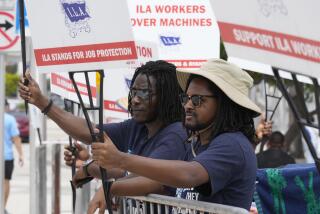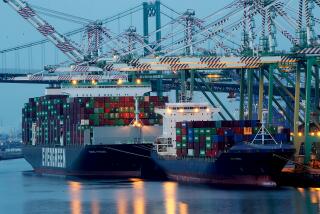Why a looming dockworkers’ strike in the East is good and bad for California

A possible dockworkers’ strike on the East and Gulf coasts as early as Tuesday means more business for Los Angeles and Long Beach ports, but it also means Santa Claus may take it on the chin along with millions of American consumers.
A strike would cause billions of dollars in economic damage and force shippers to divert more products to land in the West Coast, adding distance, time and costs for many importers and retailers. Most if not all of those costs would ultimately be passed on to consumers, along with shortages and difficulty finding popular items on local shelves.
And all those costs and hassles are likely to come at the worst possible time if striking dockworkers delay picketing until later this fall during peak holiday deliveries.
Talks have broken down between the 47,000-member International Longshoremen’s Assn. and the United States Maritime Alliance, which represents employers at some of the largest ports in the nation, including New York-New Jersey, Georgia, Texas and South Carolina.
A looming strike also puts President Biden and his chosen successor, Vice President Kamala Harris, in a political bind: If they invoke the anti-union statute forcing workers back on the job, they risk alienating a significant bloc of support. But if they don’t, they could feel a backlash from a potentially even larger population of voters across the country.
“At the end of the day, when [a strike] carries on, it’s the consumer who pays,” said Rachel Michelin, president of the California Retailers Assn., which joined more than 200 trade groups in signing a letter to the White House urging Biden to bring the parties together to avert a potentially devastating hit to businesses and the economy. Michelin said many of her member retailers, which include dozens of national brands, have made contingency plans to reroute shipments to the West Coast. “We’re going to see a backup here in California because we’re going to have to absorb more cargo.”
The dicey labor situation already had prompted companies to ship early for the holidays and send more products to Los Angeles and Long Beach, home of the busiest container complex in the U.S. The twin seaports in San Pedro Bay handled almost 1.9 million containers last month, the best August in its century-old history.
So far, top executives at both ports say the increased volume hasn’t caused bottlenecks, although wait times to move off-loaded goods by rail have gone up slightly. As of last month, the Port of Los Angeles was running at about 80% capacity and Long Beach at about 70%, so there’s room to take on more cargo.
“I’ve been very vocal about extended operation hours,” said Mario Cordero, executive director of the Port of Long Beach, adding that he’s also making sure there’s enough equipment, rails and truck chassis on hand. “If we continue to have unprecedented cargo coming, I think we’re optimistic we can handle that,” he said.
Gene Seroka says it’s a ‘generational moment’ for the Port of Los Angeles. What declining China cargo, automation, green shipping lanes and shifting political winds mean for the busiest seaport in the nation.
But there’s a limit to how much more could be handled without adding to costs and tangles beginning to develop.
At the moment there’s also plenty of available warehouse space in the region’s sprawling Inland Empire. That wasn’t so during the 2021-22 pandemic-related surge in demand for products. Many importers then quietly used the San Pedro ports to store containers, causing a logjam of ships waiting to berth and gumming up the entire supply chain system. Having learned from COVID, managers say they now have better tracking systems and tools to monitor the flow of goods to reduce risks of gridlock.
“We built a lot of resilience in the system post-COVID,” said Mike Jacob, president of the Pacific Merchant Shipping Assn., which represents container-handling terminal operators in California.
The increase in cargo volume to San Pedro Bay isn’t solely due to shippers hedging against a strike in the East. Consumer demand has been strong. And West Coast ports have benefited from a drought in the Panama Canal and security concerns in the Red Sea leading up to the Suez Canal.
And to some extent, the import gains to Los Angeles and Long Beach are a recovery of losses to Eastern seaports after the pandemic-related bottlenecks and uncertainties over West Coast labor contract talks involving the International Longshore and Warehouse Union in 2022 and 2023.
For the International Longshoremen’s Assn. on the East and Gulf coasts, it’s about getting substantial increases in wages that have been sharply eroded by inflation over the last six years of the contract. Top-scale longshoremen earn a base pay of $39 an hour. But the union is also taking a much harder line than the ILWU did on employers’ use of robotics and labor-saving automation. And, overall, the tone is much more contentious than during the West Coast negotiations, where there was relatively little saber-rattling and few people on either side viewed a strike as a serious threat.
“This has a totally different feel for me,” said Gene Seroka, executive director of the Port of Los Angeles. “I don’t think there’s any guarantee that these folks will work without a contract. The parallels between the two are very different.”
With just a few days left on the contract, the ILA’s president, Harold Daggett, has insisted that his members are prepared to strike and shut down the ports, something that hasn’t happened in almost a half-century.
“The United States Maritime Alliance may think the ILA won’t go on strike,” Daggett said in a recent video message, railing against the billions of profits that “greedy companies” have made while longshoremen endured work and suffered during COVID. “Let me tell them and all of America, the ILA will most definitely hit the streets on Oct. 1 if we don’t get the kind of contract we deserve.”
The New Jersey-based employers alliance has alleged that the ILA has refused to come to the table, and in its latest update Thursday, said it filed a complaint with the National Labor Relations Board seeking to force the union to negotiate.
The last time the ILA struck, in 1977, longshoremen flew to San Francisco where they set up pickets that the ILWU honored, essentially halting some of the cargo-handling work in California.
Last month, William Adams, the ILWU’s president, sent a letter to Daggett pledging solidarity with the ILA, but contract rules may make it harder this time for West Coast dockworkers to stop work should picket lines go up.
The White House has said that it is not considering invoking the 1947 Taft-Hartley Act to break a strike should one occur. “We support collective bargaining and believe it’s the best way for American workers and employers to come to agreement,” a Biden administration official said.
Neither federal mediators nor the Labor secretary has gotten involved yet, but some analysts wonder whether Biden and Harris could stand for a disruption to the nation’s supply chain, when the economy is emerging from a period of high inflation and the Federal Reserve has finally started to ease interest rates. Or whether the White House could afford, politically, to let a strike affect swing states like Georgia, where the Port of Savannah is one of the busiest along the East Coast and an important economic engine for a state that Democrats have some hope of winning in the November elections.
In an interview, one large sporting equipment importer in the East said that he would normally ship 60% of his products from China to the East Coast, mainly Charleston, S.C., and Savannah. Since May, he’s moved about 70% through the ports of Los Angeles and Long Beach.
The shift has made freight costs more expensive, he said, “but most of our customers fully understand this and that it is beyond our control.” The company’s owner, who asked not to be identified for competitive reasons, said he would most likely revert to the East Coast if there’s a resolution on the labor contract.
A strike, on the other hand, could cement recent surges of cargo volume to the West Coast, producing some benefit to jobs at the ports in San Pedro and parts of the vast logistics industry in the Southland. At the same time, disruptions along the East Coast and Gulf Coast ports are certain to ripple to consumers and businesses across the country.
“If some ports shut down, will we survive?” asked Mark Kirsten, whose family-owned business in Lodi, Calif., produces and distributes a variety of beans. “Of course. We’ll figure our way around it and pass on the costs associated with it,” said Kirsten, who heads the California Bean Shippers Assn. “The buck stops with the consumer.”
More to Read
Inside the business of entertainment
The Wide Shot brings you news, analysis and insights on everything from streaming wars to production — and what it all means for the future.
You may occasionally receive promotional content from the Los Angeles Times.












